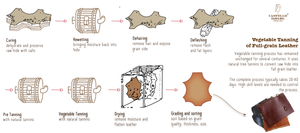Dec 07, 2017
Vegetable tanned leather
Pros:
• Vegetable tanned leather, using only natural tannins, has no negative environmental impact.
• The tanning method is ancient and requires skilled craftsmen, making vegetable tanned leather products more prestigious.
• Due to the careful tanning process and the natural tannins, vegetable tanned leather develops a rich and beautiful patina and actually gets better with time and use. It doesn’t crack or dry out and thus has a very long lifespan.
• It has an earthy and natural tone and smell.
Cons:
• The vegetable tanned leather is initially a bit stiff and has to be broken in to become fully flexible and functional.
• The colours from vegetable tanning are not as livid as in chrome tanning and darken over time.
• Vegetable tanned leather takes 30-60 days to produce, making the products generally more expensive.
Chrome tanned leather
Pros
• Chrome tanning is quick and can be easily automated and achieved in one single day. Chrome tanned products are thus cheaper and more abundant than vegetable tanned leather products.
• The colours of the leather remain unchanged during the product’s entire lifespan.
Cons
• The process of chrome tanning creates toxic wastewater that can have a detrimental environmental impact, especially in the developing world.
• Chrome tanned products don't appear very natural and can carry a chemical smell.
VERDICT
While vegetable tanned leather does take longer to produce, in a process requiring the care of skilled craftsmen, making for a more expensive product, the tradition and handmade process add to the richness and the exclusivity of vegetable tanned leather, in stark contrast to the mass-produced chrome tanned leather. It also adds to vegetable tanned leather products impressive ageing and longevity, whereas the chrome tanned products will wear badly and crack sooner rather than later.
* Text source: www.axesswallets.com
*Image : Castello Davarg. Texas USA
